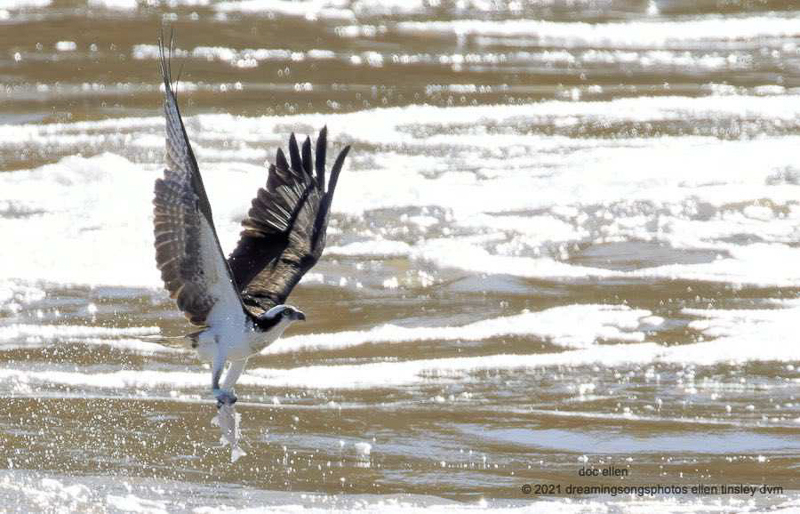Ask a Naturalist: Ospreys in Action
For immediate release ‐ April 08, 2021
Ask a Naturalist
Contact: Jessica Wackes, 919.707.9850. Images available upon request

By Cindy Lincoln, Naturalist Center Coordinator
One of our frequent Ask a Naturalist contributors, Ellen Tinsley, sent us this action shot of an Osprey catching a White Perch near the B. Everett Jordan Dam in Chatham County, NC. Ospreys are aptly called fish hawks, because this raptor lives almost exclusively on a diet of live fish. Few birds are as perfectly adapted to hunt and catch fish as the Osprey.
From high above, the osprey’s extraordinary vision enables it to accurately locate prey swimming under the water’s surface before plunging in feet-first at speeds of 30+ miles per hour. Grasping and holding onto a slippery fish is tricky business, but the Osprey’s feet have special features such as outer toes that can reverse and oppose the front toes and talons enabling a stronger grip. Plus, the surface of their toe pads is super rough due to a covering of sharp barbs called spicules.
Similar to other shore birds, osprey plumage is dense and oily, preventing their feathers from getting waterlogged. Even the nostrils located on their beaks can close completely preventing the dreaded “nose full of water.”
Where can you watch Ospreys? During the spring and summer months, they are commonly seen in estuaries, rivers and lakes of the Coastal Plain, but also along rivers and lakes in central NC. Tinsley, who is also a Bald Eagle nest monitor for the Army Corps of Engineers, recommended several areas to view these magnificent birds, including Jordan Lake and Lake Mattamuskeet in Hyde County.
Tinsley calls Jordan Lake an “eagle paradise” because it contains the largest population of Bald Eagles in NC. In addition to providing excellent habitat for Ospreys and eagles, Jordan Lake is one of only two nesting sites for Double-crested Cormorants. When asked to offer a tip for new birdwatchers, Tinsley said, “Bring all your patience with you when you go to find birds. Find a place to watch from and sit still. Let the birds come to you.”
Previous Ask a Naturalist: Deer Antlers | Older Ask a Naturalist posts
Do you have a question about a plant, animal or natural object? Be sure to Ask a Naturalist!
For more information about our upcoming activities, conservation news and ground-breaking research, follow @NaturalSciences on Instagram, Twitter and Facebook. Join the conversation with #visitNCMNS.

